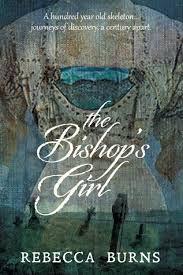 I loved Burns’ two books of short stories, Catching the Barramundi and The Settling Earth so I was happy to receive a copy of her first novel, The Bishop’s Girl. It’s a story about a team of archivists who are trying to solve a 100-year old mystery about an unknown woman found in the grave of a Bishop in 1919, the end of World War I.
I loved Burns’ two books of short stories, Catching the Barramundi and The Settling Earth so I was happy to receive a copy of her first novel, The Bishop’s Girl. It’s a story about a team of archivists who are trying to solve a 100-year old mystery about an unknown woman found in the grave of a Bishop in 1919, the end of World War I.
In the present time, Jess is a woman who is struggling with her job and her marriage. She works for Professor Waller, who has staked his entire career on finding the identity of this girl. Jess is resentful of his obsession, which she sees as interfering with her own research. Then, on a research trip to London she begins an affair with a younger man, and this only furthers the tensions in her already struggling marriage.
I found this book a little hard to get into in the beginning, mainly because it was hard to sympathize with Jess, who seems a bit self-centered. Fortunately, this book gets much better as the historical part develops. Jess’s research begins around 1899 and goes through the Bishop’s death in 1917. The mystery woman is around 18 years old, so Jess is looking for someone important to the Bishop who might have been born around 1899. Jess pays more attention than her boss does to the women who were in the Bishop’s life around that time, and she focuses on a period of time where the Bishop stayed with close friends in Greece.
While it is often clear what is going to happen, Burns develops a really interesting story with well-developed, nuanced characters. For example, the Bishop himself is a strong individual who cares deeply for the poor and doesn’t hew to religious dogma at the expense of people who are suffering. Yet at the same time, he can be thoughtless to the people he is closest to (something I’ve seen with people who are particularly devoted to a cause).
I’m often critical of books that use present-day characters to parallel a historical story. This is a device that’s often used but, in my opinion, not often done well. In books like Sarah’s Key and People of the Book, I found the present-day characters under-developed and a distraction to the real story, the history. Most of the time I’d rather read a straight historical novel than one that jumps back and forth.
In this book, I found the present-day story, once it got going, to be well-tied to the historical story. Rather than feeling like a plot device, the search for “the Bishop’s Girl” is integral to the way the story is told. I think that’s because I find the process of historical research (e.g., searching archives, traveling, interviewing witnesses) interesting in its own right, and Burns keeps the story focused on this process rather than on the character’s personal lives.
We know from the beginning that the Bishop dies while working in a World War I hospital in France, and I found this part of the story particularly interesting. I’m currently reading Vera Brittain’s Testament of Youth, a memoir about serving as a nurse in World War I, so it’s great to see the parallels between the two books. (My husband and I also hope to make a WWI trip to France in the near future so maybe I can see some of the places I’m reading about.)
If you enjoy historical fiction and are interested in this time period, I highly recommend this book, as well as other works by Burns.
Note: I received a complimentary copy of this book from the author. It was published by Odyssey Books September 17, 2016.

